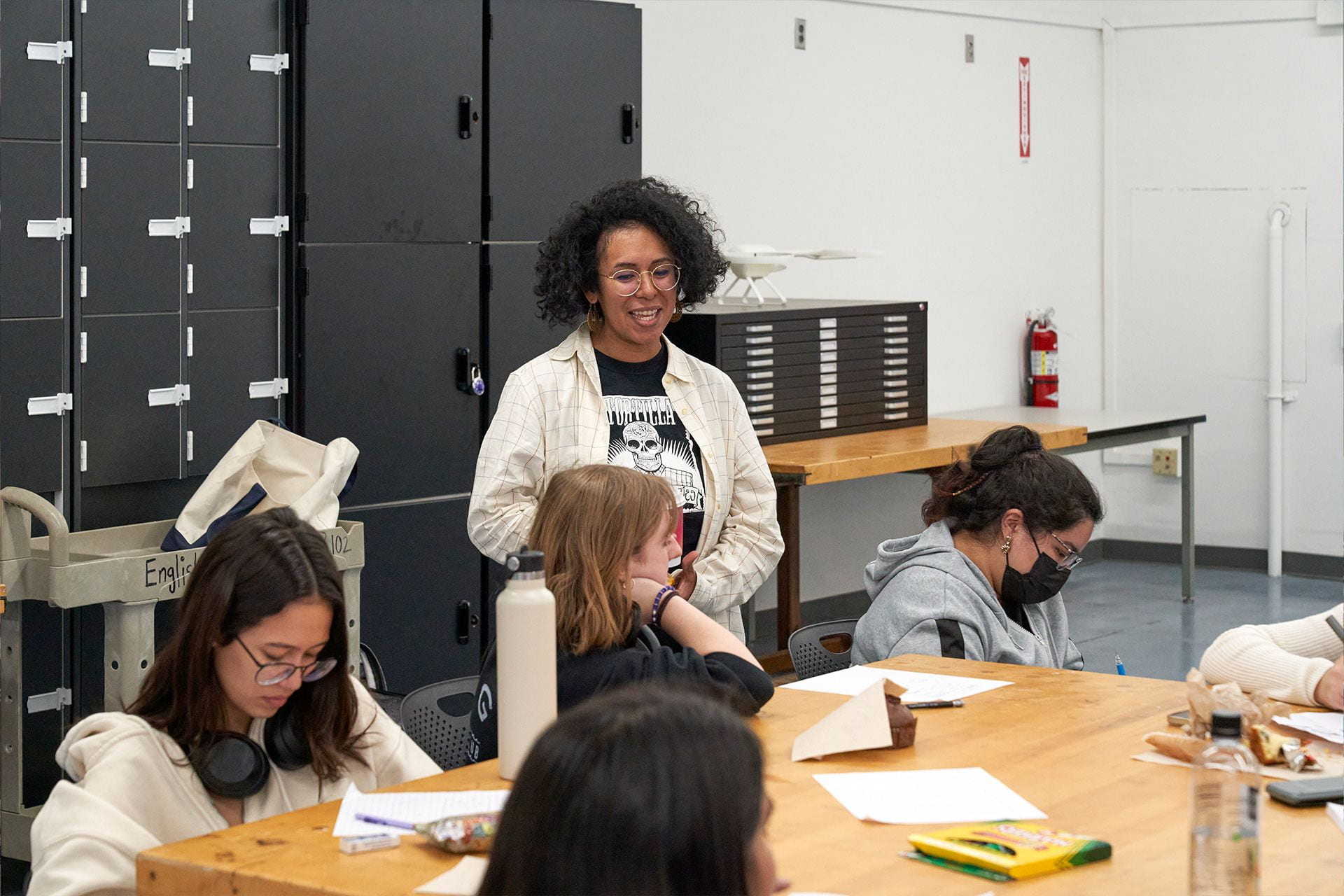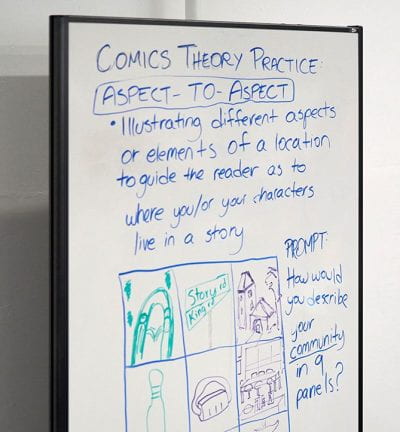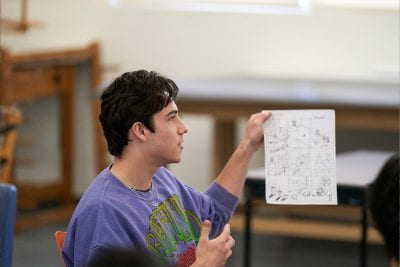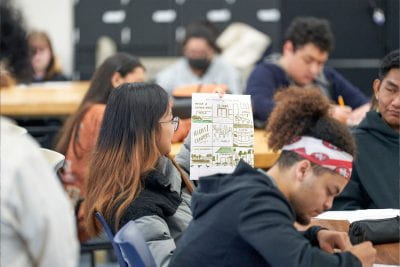Expressions Presents: Laughing My Activism Off

A workshop series helps students see how expressing themselves through comics is a form of activism. Photos in this story by Patrick Samuels, ’23 BFA Photography.
By Catherine Nguyen, ’24 English
This article was originally published by the College of Humanities and the Arts in the fall 2023 edition of Expressions, a newsletter created by students in HA-187: Creative Team Practicum. The internship course gives students the opportunity to gain professional experience in writing, graphic design, photography, and video production.
Breena Nuñez sought to create change within comics. Nuñez, who identifies as an Afro-descended cartoonist, realized the lack of representation of her culture within the media and an overall uncomfortable atmosphere around the topic of racism. With this, she made it her goal to combat these barriers; creating a space where people were allowed to express their stories through the artistic medium of comics.
 This workshop was a collaboration effort with San José State’s Department of English and Comparative Literature Assistant Professors J. Michael Martinez and Maite Urcaregui; Evonne Tan, the professors’ graduate student assistant; and Bay Area artists Lawrence Lindell and Breena Nuñez. Working together to create a workshop that allowed for freedom of expression through the creative arts, specifically through comics. The collaborators all noticed the lack of representation for minorities in media and the avoidance of discussing societal issues. Through the arts of comics and poetry, these four collaborators have created a safe space for students to share their own personal stories regarding those topics. Whether it be about their identities, culture, or issues they have faced, the workshop encouraged them to express themselves within their personal pieces. “We need diverse stories, not only autobiographical, but also fantasy. To not only see ourselves reflected, but to see experiences beyond our own,” Urcaregui states. The workshop and conversation opened up a new door for students who felt like their voices were never heard.
This workshop was a collaboration effort with San José State’s Department of English and Comparative Literature Assistant Professors J. Michael Martinez and Maite Urcaregui; Evonne Tan, the professors’ graduate student assistant; and Bay Area artists Lawrence Lindell and Breena Nuñez. Working together to create a workshop that allowed for freedom of expression through the creative arts, specifically through comics. The collaborators all noticed the lack of representation for minorities in media and the avoidance of discussing societal issues. Through the arts of comics and poetry, these four collaborators have created a safe space for students to share their own personal stories regarding those topics. Whether it be about their identities, culture, or issues they have faced, the workshop encouraged them to express themselves within their personal pieces. “We need diverse stories, not only autobiographical, but also fantasy. To not only see ourselves reflected, but to see experiences beyond our own,” Urcaregui states. The workshop and conversation opened up a new door for students who felt like their voices were never heard.
Comics are an art form that is often not seen as fine art. However, Nuñez explains that despite this, comics should not be put down as an art form, especially in the context of activism. She explains this with the idea of comics being available to everyone; it is something you can find in local newspapers, social media and sometimes even on the street. Unlike fine art, which is only found in curated art spaces, comics are a form of art that is accessible to a general audience. Nuñez explains, “Comics have always been really accessible, it allows for a larger group of people to access art and writing; that in itself is a very radical approach to creating art.”
Lindell agrees with this, as he believes that comics are also easier to digest compared to other forms of creative art, “With comics, you can take heavy information and simplify it. You can put it in a fun way where someone can enjoy it while still digesting concepts that are heavy and important.” Some stories are emotionally hard to read due to the serious subjects it is trying to address, but Lindell argues that with comics, many artists are able to surpass this uncomfortable tension in readers. It allows the author to be vulnerable and their message to come through to readers without discouraging them from reading further.
 Though comics may not be seen as a form of activism, the opportunities it creates are what makes them powerful. Professor Urcaregui elaborates, “Comics may not seem like the activism that we may be used to—it is not a protest—but it is allowing artists to retain their agency and autonomy, allowing them to share their stories and get it out there. Comics and art can still be a form of activism even without the marches and protests.” Creating spaces for these stories to be shared and heard is one of the most important aspects of the comics community. Laneha House, a publishing company created by Lindell and Nuñez, follows this same ideology; helping new artists publish their work and let their voices be heard.
Though comics may not be seen as a form of activism, the opportunities it creates are what makes them powerful. Professor Urcaregui elaborates, “Comics may not seem like the activism that we may be used to—it is not a protest—but it is allowing artists to retain their agency and autonomy, allowing them to share their stories and get it out there. Comics and art can still be a form of activism even without the marches and protests.” Creating spaces for these stories to be shared and heard is one of the most important aspects of the comics community. Laneha House, a publishing company created by Lindell and Nuñez, follows this same ideology; helping new artists publish their work and let their voices be heard.
Activism can just be a simple story of vulnerability. This can be seen through Nuñez’s journalism comic, The Nib: I Exist, a narrative she created to shed light on her mixed race and others who may share it. As Professor Urcaregui explains, “Comic artists are not only speaking out against oppression—it’s not such a narrow thing. They’re also creating their own world and speaking to their own communities and speculating different futures.” While battling against the curated spaces of fine arts where only certain individuals are allowed to access them, comics give a sense of freedom to those who wish to have a space that allows them to express their creativity and struggles.
Each collaborator had the same goal for the workshop: a space where students could share their personal stories. As Nuñez states, “I would hope people would feel seen by the work they create.” Both Nuñez and Lindell expressed that art and comics have allowed them to reflect on their struggles and find their community within those spaces, a place where they felt that they were heard and seen by the people around them. Because of their accessibility, comics have given a voice to those who felt like they were never able to tell their stories. Emphasized by Nuñez, “Students can use comics as a way to find a sense of agency for themselves. It can also help with finding people with cultural and racial similarities to themselves as well.” This sense of agency is something that all the collaborators feel is necessary for a student to feel seen in their community; by being able to create their own work and even publish it under their name, that is an opportunity that not many students and even artists have access to. To be able to create what they want and how they want is something important to comics; it allows the creator to put their feelings and struggles onto paper and fully realize it. For their work to be read by their peers, it gives them the feeling that they are not alone in this world and that their voices are reaching someone out there.
 In relation to an academic setting, the collaborators also agreed that comics being implemented in classroom settings can benefit the students as well. Nuñez argues, “Academia has not always been open to students expressing themselves through their artistry or making their art more personal to their identity.” To elaborate, academia can follow constraint rules with what can be taught and done with students. The workshop breaks through these limitations, not only for students to express themselves as individuals, but also to explore other identities and listen to other students’ own narratives. Professor Urcargui implements comics into her writing courses to not only better understand her students, but to allow them to understand themselves better as people within their society. By creating small prompts that correlate with societal issues at the beginning of class, she asks students to draw or write about their own experiences related to those prompts. She explains, “Comics pictures different identities, different positionalities and different intersectionalities on the page. It makes this visible.” Along with this, comics are easily understood and allow a lot of room for creative freedom, as Lindell explains, “The visual elements reinforce the written element making comics easier for the general audience to understand.” Comics are able to provide both a visual and literary understanding of the concepts being shown in their narrative. Lindell also states that he used comics as a coping mechanism and a way for him to fully process his emotions. The collaborators believe that comics can be used as something therapeutic for someone to discover who they are and their relation to the world they are living in.
In relation to an academic setting, the collaborators also agreed that comics being implemented in classroom settings can benefit the students as well. Nuñez argues, “Academia has not always been open to students expressing themselves through their artistry or making their art more personal to their identity.” To elaborate, academia can follow constraint rules with what can be taught and done with students. The workshop breaks through these limitations, not only for students to express themselves as individuals, but also to explore other identities and listen to other students’ own narratives. Professor Urcargui implements comics into her writing courses to not only better understand her students, but to allow them to understand themselves better as people within their society. By creating small prompts that correlate with societal issues at the beginning of class, she asks students to draw or write about their own experiences related to those prompts. She explains, “Comics pictures different identities, different positionalities and different intersectionalities on the page. It makes this visible.” Along with this, comics are easily understood and allow a lot of room for creative freedom, as Lindell explains, “The visual elements reinforce the written element making comics easier for the general audience to understand.” Comics are able to provide both a visual and literary understanding of the concepts being shown in their narrative. Lindell also states that he used comics as a coping mechanism and a way for him to fully process his emotions. The collaborators believe that comics can be used as something therapeutic for someone to discover who they are and their relation to the world they are living in.
Comics may be seen as something that is rarely correlated with activism. However, the workshop fights against this stereotype. The collaborators encourage students to tell their stories through the art form, allowing for their voices to be heard by those around them. Creating this space for the students is itself a form of activism; allowing students to express their dissatisfactions within their society freely is something not everyone has access to. For students to be able to connect and reflect on themselves and others is a necessity. Comics are a way to give voices to people, to allow people to understand themselves and others. Professor Urcaregui says, “Engaging with these diverse comics and learning from them allows us to create spaces to give a voice to diverse experiences and narratives.”




